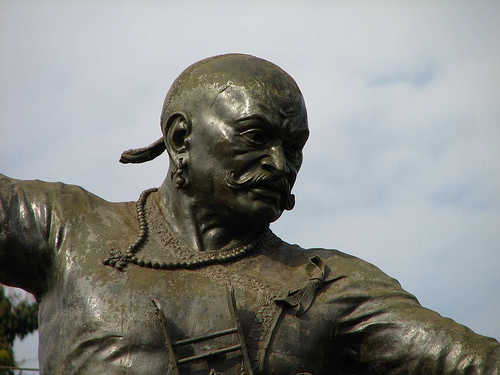The Battle of Paavan Khind
It was a dark, dismal night. A mournful wind was howling through the narrow pass known as Ghodkhind. The date was 16th July 1660. Even the pouring July rain could not wash away the caked blood from the exhausted, gaunt faces of the handful of Bandal warriors still fighting. Corpses littered the stony ground. They were three hundred when this battle started, and now, almost five hours later, there were barely twenty five Bandal warriors still standing.
Their leader, a thick set man of about fifty, fought like a man possessed. His shield had long been broken into pieces, his shaven head lay exposed without his turban, thick clumps of clotted blood covered his forehead. He fought with two swords, moving with the agility of a leopard, charging at the enemy with the naked fury of an injured tiger. His brother, Fulaji lay dead on the ground, after having fought a pitched battle with the Adilshahi commander, but Baji Prabhu Deshpande did not have the time to grieve. His Raja had still not reached the sanctuary of Vishalgad. The three cannon shots had not been fired yet.
The enemy was charging hard now, sensing an advantage. It had been an unequal battle from the start. 300 Bandal soldiers against the might of a 4000 strong Adilshahi contingent led by Siddhi Masood, the son-in-law of Siddhi Johar – the Abyssinian general of the Adilshahi army. Baji Prabhu Deshpande and his troops had facilitated Shivaji Maharaj’s audacious escape from Panhalgad on the stormy night of Gurupournima. Panhalgad has been under a month long siege by Siddhi Johar’s vast army. Shivaji Maharaj and a few of his closest associates were stuck inside the fort. It had been a long month and supplies were almost beginning to run out at the Panhala fort. Shivaji Maharaj’s chief of army staff Netaji Palkar had made three attempts to break the siege, only to be repulsed each time.
The lion of Sahyadri was well and truly trapped inside Panhala fort. Finally, in desperation, a very audacious plan was hatched to enable Shivaji Maharaj to escape the siege. Shivaji, Baji Prabhu Deshpande and a select band of soldiers would attempt to break through the siege at the night, and make a non-stop run for Vishalgad, a fort some 40 kms. Away. In order to pull the wool over the Bijapuri forces’ eyes, a decoy was planned. A barber called Shiva Kashid, who had an uncanny physical resemblance to Shivaji, had volunteered to dress like Shivaji and escape from the fort mounted in a palanquin. Shiva had volunteered for the job even though he knew fully well that he would be put to death if discovered. The plan worked for a while. The Bijapuri army followed and arrested Shiva Kashid and when they discovered that he was an imposter, they killed him mercilessly. But Shiva had done his duty. His sacrifice had bought precious time for the fleeing Bandal forces on their way to Vishalgad.
When Baji Prabhu Deshpande realised that they were being pursued by a vast army of 4000 soldiers, he begged Shivaji Maharaj to proceed towards Vishalgad with half the troops without wasting any time, while he himself along with his brother Fulaji chose to make a final stand at Ghod Khind, an extremely narrow pass between two tall mountains that stood between Panhalgad and Vishalgad.
It was a long, brutal battle. Baji Prabhu’s small band of soldiers exhausted from the long straight run from Panhalgad fighting against an enemy contingent several times bigger, armed with cannons as well as swords. The Bandal troops fought heroically. Through the entire battle, Baji Prabhu, even though he was grievously injured, continued fighting, inspiring his men to fight on until Shivaji’s safe arrival to Vishalgadh was signaled by the firing of three cannon shots. The battle had lasted for hours, sapping the last ounces of strength from the exhausted Bandal warriors. Baji Prabhu himself was wounded in several places, but the final blow came in the shape of a cannon ball that hit him squarely on the chest.
Baji Prabhu fell, stunned with the blow. The pain would have killed any mortal, but Baji Prabhu could hardly feel anything. All his attention was focused on the one sound that he was desperate to hear – the sound of the three cannon shot. When the sound was not forthcoming, Baji Prabhu Deshpande gathered every ounce of willpower he had and with a super human effort, roused himself to a standing position. ‘No sound of the cannon volleys. Baji cannot die yet’, he roared. Baji Prabhu Deshpande charged blindly at the enemy, his broken arm barely able to bear the weight of the sword. He and his men had been riding and fighting for over seven hours, without a pause. The few men who were still alive followed their leader unhesitatingly and hurled themselves at the solid wall of the charging Bijapuri troops. A fierce suicidal battle ensued.
Boom. Boom. Boom.
At last, Ghod Khind reverberated with the sound of the three cannon shots! Shivaji Maharaj had reached Vishalgad safe and sound, breaking through siege of Vishalgad by Bijapuri generals Suryarao Surve and Jaswantrao Dalvi. Baji Prabhu Deshpande heard the three shots. Happiness spread over his scarred face, as the sword fell from his hands and he hit the ground with a crash. ‘Maharaj has reached Vishalgad, NOW Baji Prabhu Deshpande can die in peace’, he whispered, as his eyes shut for ever.
Baji Prabhu Deshpande will always be remembered for the heroic battle of Ghod Khind. The Ghodkhind pass was subsequently named Paavan Khind (“Holy Pass”) by Shivaji, in honor of the sacrifice of Baji Prabhu and his troops. Shivaji Maharaj honoured Baji Prabhu’s family with “maanache pahile paan” – a court honour.
Baji Prabhu Deshpande was a Sardar (knight) from the Hirdas region in Maval area that is today a part of Bhor taluka in Pune district. Baji had once worked for the Bandal Deshmukh family that had fought against Chhatrapati Shivaji Maharaj. But Shivaji Maharaj was an excellent judge of people. He recognised Baji Prabhu’s valour and loyalty and won him over to the cause of Swarajya. Baji Prabhu Deshpande was fifteen years older than Shivaji Maharaj. Baji and his brother Fulaji served Shivaji Maharaj with dedication.
Baji and Fulaji Prabhu Deshpande’s heroic last stance has been the stuff of legend in Maharashtra. Baji Prabhu’s sacrifice continues to inspire people even today. A Marathi poem describes them in the following glowing words;
Ranachandiche janu pujari, PaavanKhindiche gaji
Vishalshaili disati doghe, Baji aani Phulaji
(Devotees of the goddess of war, the warriors of Paavan Khind,
Larger than life they were, both Baji and Phulaji)


































Test Comment